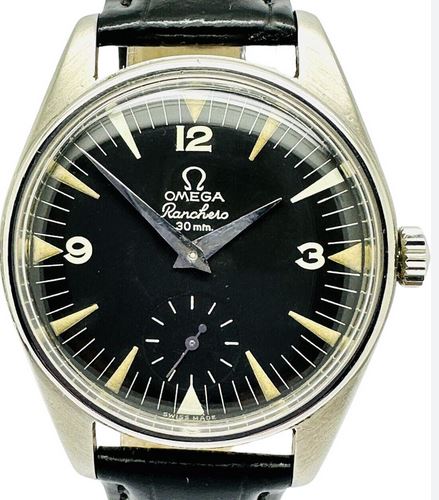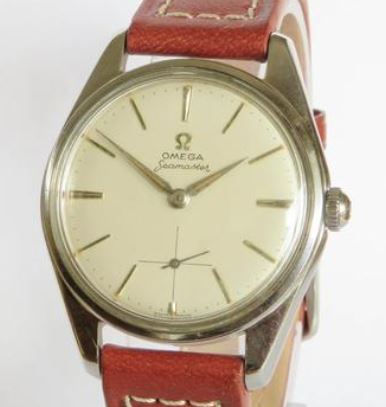In my never-ending online search for vintage watches, I stumbled across this Omega Seamaster 2990 (Ranchero). The Ranchero was not a model I was familiar with, so it caught my attention. The watch in question was originally an Omega Ranchero with a replacement dial and hands from a Seamaster. The watch in question had been sold by the Vintage Wrist Watch Company. I have spent some time researching the Ranchero, and I will share what I have learnt in this post.
The origin of the Omega Ranchero
The Omega Ranchero was launched in 1958. It joined Omega’s famous tool watch Trilogy, the Speedmaster, Railmaster and Seamaster. Omega designed the Ranchero as an all-around watch, meant for everyday use. The watch was built to tough standards, but its slim design meant it was versatile. It could be worn for both work and play (Omega 1957 Trilogy at Worn & Wound).
The Ranchero used design cues from its established siblings. It featured broad arrow hands and Arabic numerals. It’s 36mm in diameter, 9mm in thickness, and the stainless steel case has a slim profile that would easily slide under the cuff of a dress shirt. The watch was even nicknamed the “Fourth Musketeer”. It offered a similar style to its noted brethren, but at a more affordable price.
Production years
Omega introduced the Ranchero in 1958. However, its production run was very short. Many sources indicate it was phased out within two years. Some sources state a single year of production. However, the general consensus points to a disappointingly brief market presence. Omega pulled it so quickly that historical records or memories might be imprecise. This short production run is a significant factor in its current rarity, elevating its importance to collectors. Good examples fetch significant prices.

Omega Ranchero specifications
The Omega Ranchero was primarily made from stainless steel. Its case diameter was typically 36mm. The thickness was around 10mm. Lug-to-lug measurements were about 44mm. It featured a Plexiglass crystal.
Several manual-winding calibres powered the Ranchero, the Calibres 267 and 284. Rarer was the Calibre 268. These movements were part of Omega’s robust 30 T2 series. They are known for their reliability and accuracy (Omega movements at EmmyWatch).
Dial variations included black and white versions. The black dial often featured an “Explorer” style 3-6-9 layout. Dagger indexes were common. The luminescence source was radium. Broad arrow hands were a defining feature. The dial might also state “30mm,” referring to the movement’s diameter.
The use of multiple manual-winding calibres within the Ranchero’s short production run suggests Omega’s flexibility in movement sourcing. This might also indicate minor internal revisions. Despite these variations, the consistent use of movements from the robust 30 T2 family highlights the watch’s inherent quality. This makes its ultimate commercial failure more a matter of marketing than the underlying mechanics.
Target market
The Ranchero was meant to be a versatile watch. Unlike specific tool watches, it was a jack of all trades, master of none. Its design allowed for both work and play. It was created as an entry-level wristwatch that pulled style elements from the Speedmaster, Railmaster, and Seamaster, but at a much more affordable price. The price in 1959 was 147 francs. A Railmaster cost 245 francs (Omega Ranchero 2990-1 at Wrist Icons).
The watch had a slimmer profile. This made it suitable for dressier occasions. The thin crystal made the dial stand out. This was a feature seen in Omega’s dress watches. It combined robustness with elegance. The Ranchero’s intended market represented a significant departure from Omega’s highly successful, purpose-built tool watches. By aiming for a “do-it-all” and “entry-level” position, Omega tried to capture a wider, less specialised consumer base.
Why did the Ranchero fail?
The Omega Ranchero was a commercial failure. Its sales fell flat. This was despite its impressive build quality and pleasing appearance. The primary reason for its poor sales was its name. “Ranchero” roughly translates to “ranch hand”. In Spanish-speaking markets, this name caused resistance. In wider markets, it came across as unsophisticated, which was hardly suitable for an upmarket watch.
Omega quickly discontinued the watch. Production stopped shortly after its release. The remaining units were sold in 1959. The Ranchero’s failure provides a compelling example in global marketing. Despite a strong product and competitive pricing, a single misstep in naming led to its demise.
The Ranchero’s appeal to collectors
The Ranchero is now highly sought after, despite its initial failure. Its short production run makes it very rare. Collectors consider it a “unicorn”. Good examples command high premiums, and their value continues to trend upwards. Collectors appreciate its design elements. It shares styling with the iconic Speedmaster and Railmaster. The broad arrow hands are particularly desirable. Its slim profile also appeals (Omega Ranchero at Chrono24).
“Transformed Ranchero” watches
The term “transformed Ranchero” refers to watches that are not entirely original. This often involves modifications or rebranding. The term typically refers to Ranchero watches with replacement Seamaster dials. To address the unsold stock of Ranchero cases and movements, Omega sometimes fitted them with a “Seamaster” dial. This blending of the Ranchero’s physical form with the successful Seamaster branding created what collectors now call the “Seachero”.

The broader term “Frankenwatch” also applies to these versions of the Ranchero. A Frankenwatch combines parts from different sources. These parts can be authentic or non-authentic. They might be period-correct or incorrect. (Frankenwatch at British GQ).
The 1970s Belgian Ranchero revival
The Ranchero name saw a limited revival. This occurred in Belgium during the 1970s (1974 – 1976). However, it was a short-lived reissue. This specific release was solely for the Belgian market. This 1970s model was distinct from the original. It featured an automatic Omega 1012 movement. The original watches used manual-winding calibres (Belgian market revival at Gear Patrol).
Conclusion
The Omega Ranchero, though a commercial misstep in its brief 1958-1959 run, holds a unique place in watchmaking history. Its failure was not due to mechanical shortcomings or poor design, but from a marketing misjudgement. The name just didn’t appeal to the watch-buying public. Today, the Ranchero’s initial lack of success actually fuels its desirability. Its extreme rarity, as a result of its short production run, makes it a prized item for collectors. The existence of “transformed” versions, like “Seacheros,” further underscores this high demand. These modifications reflect the market’s response to scarcity. However, I don’t see the appeal. Why pay the premium for what is essentially a Seamaster?
Leave a Reply